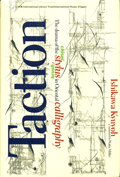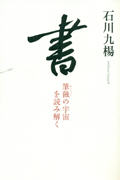Explaining Why Chinese Characters Move Vertically (tb-rl)

節錄 = Excerpts from Taction: The Drama of the Stylus in Oriental Calligraphy / by Ishikawa Kyuyoh (Tokyo: International House of Japan, 2011),
Chapter 3, p. 55
Tanslation by Waku Miller of 書: 筆蝕の宇宙を読み解く / 石川九楊 (東京: 中央公論新社, 2005), p. 68

VERTICALITY
Calligrapher's spiritual orientation
About Straightness
We will examine in this chapter some spiritual aspects of calligraphic aesthetics. The most fundamental criterion in the aesthetics of calligraphy is the quality
of straightness. And the preoccupation with that quality evidences a strong spiritual orientation.
An emphasis on straightness figures prominently in parental admonitions, like "sit up straight" or "look me straight in the eye." It also figures prominently
in advice of all kinds, such as "walk the straight and narrow path" and "always be straight with people."
In calligraphic appreciation, we naturally tend to favor characters that exhibit good lateral balance and uniform size. We also tend to favor precisely vertical
columns of evenly spaced characters. That partiality to straightness dates from the earliest days of writing. It is the aesthetic of the vertical linkages
between heaven and earth.
The aesthetic of heaven-to-earth verticality spawned—and continues to encompass—the derivative aesthetics of lateral balance and evenly ordered
spacing. Inevitably, calligraphic movements arose in opposition to the emphasis on straightness, and calligraphers created work that defied what they regarded as the
stifling limitations of rigorous straightness. Those calligraphers' conscious opposition to the aesthetic of straightness positioned their work, however, as a
variation on that very aesthetic.

|
|
第三講 垂線の美学—書と宗教
「真っ直ぐ」ということ
‧ ‧ ‧
私たちは子供を躾る際に、「背筋を真っ直ぐに伸ばしなさい」とか、「真っ直ぐにこちらを見なさい」などという言葉を口にします。あるいは目上の人が若い人を諭して、「真っ直ぐに歩みなさい」というとき、それは「曲がることなく、正直な生き方をしなさい」という意味を込めています。「真っ直ぐ」という
言葉には、たしかに強烈な倫理的価値が含まれています。
「真っ直ぐ」とは、書においても、美の最も基本的な基準です。
左右のバランスのとれた文字、均等な間隔で並んでいる字粒の揃った文字、垂直に一直線に行が揃った文字は、一見して誰もが美しいと感じるでしょう。これら左右均衡の美、均整の美の根幹にあるのが、「真っ直ぐ」ということです。
「真っ直ぐ」とは、結論からいえば、文字の誕生と揆を一にして成立した美学であり、「天地を結ぶ垂線の美学」です。垂線の美学は、そこから左右均衡と均整の美意識を派生させ、なおかつそれらを包摂する書の根幹の美学です。やがて垂線の美学に反発し、そこから逸脱しようとする
新しい美学も生まれます。しかしこの新しい美学もまた、垂線の美学への反発であり逸脱である限りにおいて、やはり垂線の美学のヴァリエーションであるといえます。
‧ ‧ ‧
|
Sources: As cited at top
Web HTML by Louis Chor, October 2011, updated September 2020


